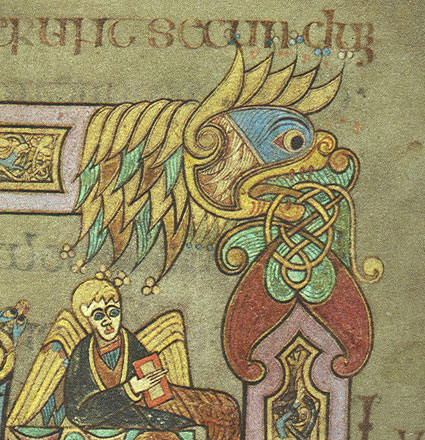Category — Poll Results
The Book of Kells in the News

There may be no more famous example of an illuminated manscript than the Book of Kells. While it is well known as one of the most beautiful surviving illuminated manscripts, surprisingly, very little is actually known about the manuscript and its origins. Finally, modern science will be used to learn more about this treasure. From the Dublin Journal as reported in the New York Times:
Experts at Trinity College in Dublin, where the Book of Kells has resided for the past 346 years, are allowing a two-year laser analysis of the treasure, which is one of Ireland’s great tourist draws.
The 21st-century laser technology being used, Raman spectroscopy, encourages hopes among those with a romantic view for an ecclesiastical intrigue like “The Da Vinci Code†or “The Name of the Rose.â€
But the precise subjects are more mundane. The laser will study the chemicals and composition of the book, its pigments, inks and pages of fine vellum. Experts estimate that 185 calves would have been needed to create the vellum on which the art and scriptures were reproduced.
This news happens to coincide with the opening of The Medieval Scriptorium’s on-line gallery of images from the Book of Kells. I have to admit that the gallery is not complete. I haven’t had time to finish all of the captions for the images but I decided to introduce it in this post in light of the recent story referenced above.
[tags]Book of Kells, illuminated manuscript, celtic, calligraphy[/tags]
May 29, 2007 1 Comment
Poll Results – The 14th Century Black Death – Which Animal Survived Unscathed?
Twenty-three votes were cast in the Scriptorium’s first poll. The question was about the 14th century plague popularly referred to as the Black Death. While we commonly think of the rat acting as a host for fleas and the plague bacillus, it was certainly not the only animal that carried the disease. Besides humans and rats, most animals were susceptible to the bacillus and were infested with fleas. There was, however, one exception. These animals actually repelled fleas and humans who lived and worked closely with this species enjoyed some protection from the plague. The choices presented in the poll were pigs, cows, horses and sheep. The correct answer was the horse. From “The Black Death: Natural and Human Disaster in Medieval Europe” by Robert S. Gottfried:
…important as black rats were in the dissemination of plague, it is essential to emphasize that they were not the only secondary carriers. Along the other rodents already mentioned, additional secondary vector hosts included virtually all household and barnyard animals save the horse, whose odor apparently repels even starving blocked fleas.
Since first reading that short paragraph many years ago, I couldn’t help thinking that this little tidbit of knowledge could somehow be turned into a natural flea product. I’m sure it would probably be much less toxic than the chemicals we use to treat our pets today.
May 6, 2007 Comments Off on Poll Results – The 14th Century Black Death – Which Animal Survived Unscathed?

